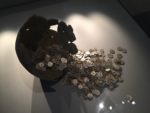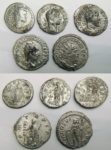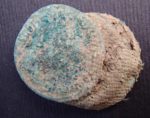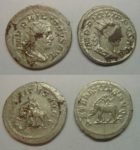 A hoard of 3,339 Roman coins unearthed in March of 2013 has gone on display at the Museum of Somerset in Taunton, just a hop, skip and a jump from where they were found in Yeovil.
A hoard of 3,339 Roman coins unearthed in March of 2013 has gone on display at the Museum of Somerset in Taunton, just a hop, skip and a jump from where they were found in Yeovil.
The hoard was discovered neither by archaeologists nor by metal detector enthusiasts. This one was found by bulldozer driver Mark Copsey who was moving masses of earth during installation of a fake turf hockey pitch at the Yeovil Recreational Centre. We have his exceptionally keen eye to thank that the hoard wasn’t scattered to the four corners of the earth and the vessel destroyed. After he leveled the old hockey field, he looked back upon his works, ye mighty, and saw a green stain on the newly  exposed surface of the soil. Upon further investigation, he saw coins and the remains of the pot (the top of it had been sheered off by the bulldozer). He contacted South West Heritage Trust who sent experts to explore the find site. The coins he had already picked up and put in a sealed bag were sent along to the British Museum for examination. The in situ coins and greyware vessel fragments were raised en bloc and excavated in controlled conditions in the BM lab.
exposed surface of the soil. Upon further investigation, he saw coins and the remains of the pot (the top of it had been sheered off by the bulldozer). He contacted South West Heritage Trust who sent experts to explore the find site. The coins he had already picked up and put in a sealed bag were sent along to the British Museum for examination. The in situ coins and greyware vessel fragments were raised en bloc and excavated in controlled conditions in the BM lab.
 Conservators found that all of the coins date to the 2nd-3rd centuries A.D., most to the 3rd. The most recent coins in the hoard date to around 270 A.D., which is probably around the time they were buried, a period of turmoil in Britain when usurpers created a splinter “Gallic Empire” and ruled as rivals to the official Roman emperor. The overwhelming majority of the coins, 3335, to be precise, are base silver coins. Out of that number, only 165 are silver denarii. The rest are less valuable radiates which became the most circulated denomination in the 3rd century. The remaining four of the 3,339 coins are large brass sestertii. In the 3rd century, four sestertii were worth a single silver denarius.
Conservators found that all of the coins date to the 2nd-3rd centuries A.D., most to the 3rd. The most recent coins in the hoard date to around 270 A.D., which is probably around the time they were buried, a period of turmoil in Britain when usurpers created a splinter “Gallic Empire” and ruled as rivals to the official Roman emperor. The overwhelming majority of the coins, 3335, to be precise, are base silver coins. Out of that number, only 165 are silver denarii. The rest are less valuable radiates which became the most circulated denomination in the 3rd century. The remaining four of the 3,339 coins are large brass sestertii. In the 3rd century, four sestertii were worth a single silver denarius.
 At least some of them had been stacked in little piles and wrapped with textiles before being buried in the pot. In one of those great archaeological flukes that descend upon us all too rarely, the corrosion from the metal created a sort of caked-on crust that ensured the survival of fragments of organic textiles even though the ground wasn’t waterlogged or a peat bog or extremely dry or extremely cold.
At least some of them had been stacked in little piles and wrapped with textiles before being buried in the pot. In one of those great archaeological flukes that descend upon us all too rarely, the corrosion from the metal created a sort of caked-on crust that ensured the survival of fragments of organic textiles even though the ground wasn’t waterlogged or a peat bog or extremely dry or extremely cold.
 The hoard contains a large array of different coins struck under different emperors (40 emperors and empresses, to be precise) some of them of significant historical note. There’s a series of coins struck in 248 A.D. during the reign of Emperor Philip I which commemorate the 1,000th anniversary of the founding of the city of Rome. Their reverse sides depict exotic animals — hippos, elephants, lions — thousands of whom were slaughtered in the games celebrating the millennium birthday.
The hoard contains a large array of different coins struck under different emperors (40 emperors and empresses, to be precise) some of them of significant historical note. There’s a series of coins struck in 248 A.D. during the reign of Emperor Philip I which commemorate the 1,000th anniversary of the founding of the city of Rome. Their reverse sides depict exotic animals — hippos, elephants, lions — thousands of whom were slaughtered in the games celebrating the millennium birthday.
 Two months after its discovery, the Yeovil Hoard was declared Treasure and valued by the Treasure Valuation Committee at £53,500 ($71,000). The usual practice is for a local museum to be offered the treasure contingent on their paying the assessed value as a reward to the finder and landowner. At first it looked like they might be in for a bumpy ride. One of Mark Copsey’s co-workers claimed it was a “group find” and that they all should get a cut, but the coroner’s inquest determined there was no basis for the claim. Copsey was declared the finder free and clear.
Two months after its discovery, the Yeovil Hoard was declared Treasure and valued by the Treasure Valuation Committee at £53,500 ($71,000). The usual practice is for a local museum to be offered the treasure contingent on their paying the assessed value as a reward to the finder and landowner. At first it looked like they might be in for a bumpy ride. One of Mark Copsey’s co-workers claimed it was a “group find” and that they all should get a cut, but the coroner’s inquest determined there was no basis for the claim. Copsey was declared the finder free and clear.
 The Museum of Somerset declared its desire to acquire the hoard in no uncertain terms and launched a fundraiser. The South Somerset District Council, owners of the hockey pitch and rec center where the hoard was discovered, were very much in support of the goal of keeping the hoard close to where it was found. They decided to waive their rights to half the reward, leaving the museum with £26,750 to raise. They got donations from individuals, the Friends of the Museum of Somerset and grants from several art/cultural patrimony funds. It took more than a year, but the fee was raised in full and now the Yeovil Hoard will be exhibited in a local museum, albeit one that was recently renovated for millions of pounds and is now a state-of-the-art facility.
The Museum of Somerset declared its desire to acquire the hoard in no uncertain terms and launched a fundraiser. The South Somerset District Council, owners of the hockey pitch and rec center where the hoard was discovered, were very much in support of the goal of keeping the hoard close to where it was found. They decided to waive their rights to half the reward, leaving the museum with £26,750 to raise. They got donations from individuals, the Friends of the Museum of Somerset and grants from several art/cultural patrimony funds. It took more than a year, but the fee was raised in full and now the Yeovil Hoard will be exhibited in a local museum, albeit one that was recently renovated for millions of pounds and is now a state-of-the-art facility.
 Somerset has been on a long roll hoard-wise. The spectacular Frome Hoard, 52,503 Roman coins buried in a single pot, was found less than 30 miles northeast of Yeovil and is now on display at the Museum of Somerset, as is the Shapwick Hoard, discovered in 1998 and still the largest group of silver denarii found in Britain. The museum is also the permanent home of the Priddy Hoard, gold jewelry buried 1300-1100 BC. during the Bronze Age, and from the same date range, a twisted gold torc that is widely acknowledged as the finest piece of gold work ever discovered in Somerset.
Somerset has been on a long roll hoard-wise. The spectacular Frome Hoard, 52,503 Roman coins buried in a single pot, was found less than 30 miles northeast of Yeovil and is now on display at the Museum of Somerset, as is the Shapwick Hoard, discovered in 1998 and still the largest group of silver denarii found in Britain. The museum is also the permanent home of the Priddy Hoard, gold jewelry buried 1300-1100 BC. during the Bronze Age, and from the same date range, a twisted gold torc that is widely acknowledged as the finest piece of gold work ever discovered in Somerset.
Stephen Minnitt, head of museums at South West Heritage Trust, said: “Somerset has gained a reputation for the exceptional number of Roman coin hoards discovered in the county – these include the well-known Shapwick and Frome hoards.
“We are delighted that, thanks to the support of our funders and the district council, we have also been able to secure the Yeovil Hoard for the county.”